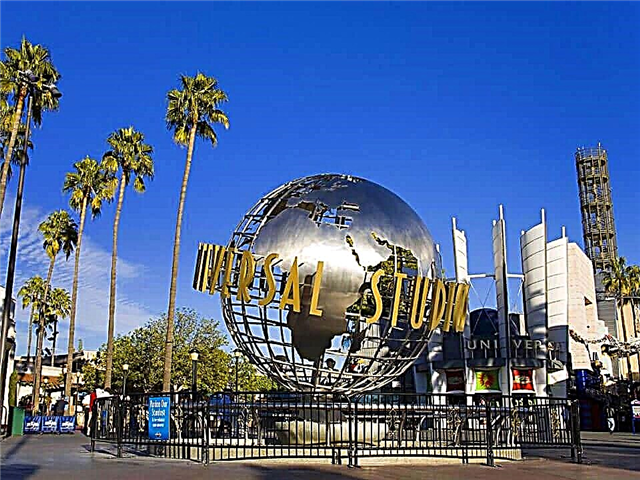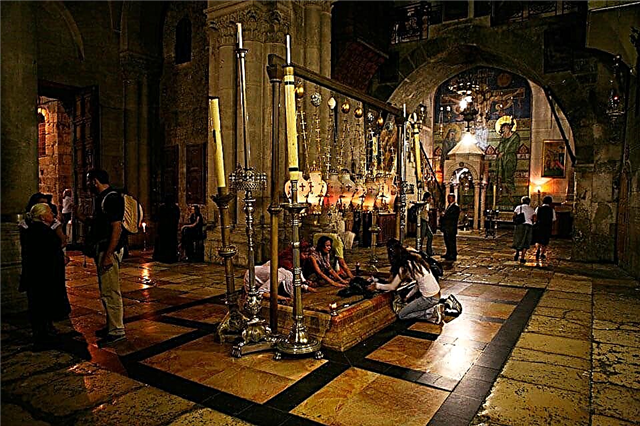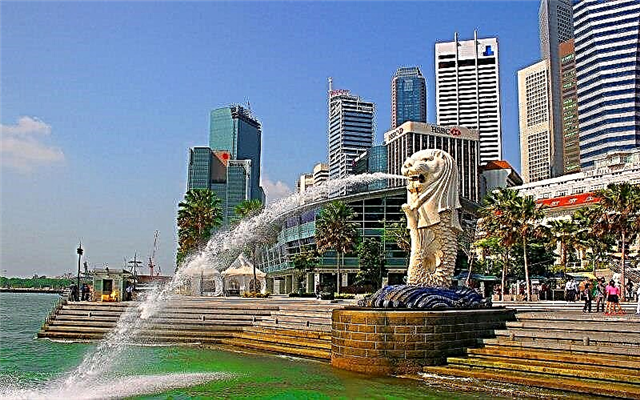More than 50 kremlin and other fortifications have survived in Russian cities and villages. Ancient military fortresses are living witnesses of barbaric raids, devastating wars, peasant uprisings and riots. All of them have the status of architectural monuments and attract many tourists.
Moscow Kremlin
Article: Moscow Kremlin - the sovereign crown of Russia

View of the Moscow Kremlin from the Bolshoi Kamenny Bridge
The most recognizable Kremlin in Russia rises on Borovitsky Hill, in the center of the Russian capital. On the territory of the historical monument there are ancient cathedrals, burial places of Russian tsars and patriarchs, unique monuments, Armouries and the Diamond Fund. For several centuries the Moscow Kremlin has been the administrative center for governing the country.
Nizhny Novgorod Kremlin
Article: Nizhny Novgorod Kremlin - a stone necklace of the city

Bird's eye view of the Nizhny Novgorod Kremlin
Near the confluence of the Volga and Oka rivers there is an old Kremlin, where the center of state administration of Nizhny Novgorod is located. This well-restored historical monument is one of the city's main attractions. Tourists come here to admire the stone towers and the ancient Archangel Michael Cathedral.
Suzdal Kremlin
Article: Suzdal Kremlin - the heart of the ancient city

View of the buildings of the Suzdal Kremlin
The Suzdal Kremlin traces its history back to the times of Vladimir Monomakh. The first wooden fortifications on the high bank of the Kamenka appeared in the 10th century. Nowadays, ancient buildings have the status of a museum-reserve. The majestic Nativity Cathedral, Nikolsky Church and the Bishops' Chambers are located here.
Kazan Kremlin
Article: Kazan Kremlin - the visiting card of the Tatar capital

Bird's eye view of the buildings of the Kazan Kremlin
The main attraction of the capital of Tatarstan is a stone fortress in the center of the city. The Kremlin was built at the behest of Tsar John IV the Terrible after the destruction of the wooden fortifications of the Kazan Khanate. On the territory of the old citadel are the residence of the President of the Republic of Tatarstan, churches, cathedrals and the Kul-Sharif mosque.
Kolomna Kremlin
Article: Kolomna Kremlin - stone protection of the ancient city

Bird's eye view of the Kolomna Kremlin
The powerful fortress was built in 1525-1531 and was considered the largest and most formidable fortification of its time. After Kolomna ceased to act as a military outpost, local residents began to dismantle the towers and walls into bricks. Only thanks to the tsar's decree, the old Kremlin was preserved for posterity.
Pskov Kremlin
Article: Pskov Kremlin (Krom) - the main fortress of the Pskov land

General view of the Pskov Kremlin
The inhabitants of Pskov call the ancient fortification Krom. A small fortress on a high hill has an area of 3 hectares. It has been partially restored and is open to tourists. From the powerful stone walls 6-8 m high, beautiful views of the confluence of the Velikaya and Pskova rivers open.
Rostov Kremlin
Article: Rostov Kremlin - the ancient residence of the Metropolitan of the Rostov diocese

View of the Rostov Kremlin
Fortifications in Rostov the Great appeared in 1670-1683 and served as the residence of the Metropolitan of the Rostov diocese. Today the Kremlin has 11 towers and is divided into 3 parts - the square with the Assumption Cathedral, the Metropolitan Garden and the Bishop's Court. The enamel museum, which is popular with tourists, is located on the territory.
Uglich Kremlin
Article: Uglich Kremlin - the heart of the ancient city

Uglich Kremlin from the Volga
The beautiful architectural ensemble on the high right bank of the Volga is not at all like a fortress. In the Uglich Kremlin, the chambers of local princes, an ancient cathedral, a high bell tower, the building of the city council and the famous temple of Tsarevich Dimitri have survived.
Novgorod Kremlin
Article: The Novgorod Kremlin is the oldest fortress in Russia

Bird's eye view of the Novgorod Kremlin
For the first time the Novgorod fortress was mentioned in the annals of 1044. At first it was made of wood, but in the middle of the 11th century, the construction of an earthen rampart, stone walls and towers began. Novgorod Detinets is so beautiful that he was depicted many times on Russian banknotes and coins.
Tula Kremlin

General view of the Tula Kremlin
Several centuries ago, the stone citadel was intended to protect Moscow from invasions from the south. White limestone and large red bricks were used for the construction of the Kremlin. The same craftsmen who built the Moscow Kremlin worked in Tula, therefore, on the walls of ancient fortifications, you can see the same forked battlements.
Astrakhan Kremlin

Astrakhan Kremlin from a bird's eye view
Almost all excursions in Astrakhan begin from the old Kremlin, which is considered a perfectly preserved example of medieval fortification architecture of the second half of the 16th century. There are 22 historical monuments built in the 16th-20th centuries on the territory. Museums and exhibitions in the Kremlin are dedicated to the military history of Russia.
Tobolsk Kremlin

General view of the Tobolsk Kremlin
The only stone Kremlin in Siberia was built in the 17th-18th centuries. After the death of the young Tsarevich Dimitri, the bell from Uglich was sent to a distant exile. On carts, he was transported to the Tobolsk Kremlin and hung on a specially built bell tower.
Ryazan Kremlin

Ryazan Kremlin from a bird's eye view
One of the most ancient kremlin in Russia is mentioned in the annals of 1300. The picturesque architectural complex on the Kremlin hill is visible from afar. From any side, at the entrances to Ryazan, an excellent view of the historical core of the city opens.
Zaraisk Kremlin

View of the Zaraisk Kremlin
The old fortress was built by order of Vasily III in 1528-1531. Only two years have passed, and the stone walls have tested the strength of the troops of the Crimean Tatars. The Kremlin in Zaraysk was attacked several more times, but it withstood and repelled all the attacks of the enemies.
Dmitrov Kremlin

General view of the Dmitrov Kremlin
The partially preserved fortress in the city of Dmitrov from the north of Moscow differs from other Russian kremlins. She never got stone walls. The fortification has the shape of an egg and is surrounded by ramparts with a moat. Once upon a time there were wooden walls and towers at the top, but they were destroyed in the Time of Troubles.
Syzran Kremlin

View of the Syzran Kremlin
The only fortress in the Samara region appeared in the city at the end of the 17th century. Small fortifications consisted of chopped walls and five towers. To this day, only one tower has survived from the Kremlin in Syzran - Spasskaya. Today it houses a branch of the local museum of local lore.
Verkhoturye Kremlin

General view of the Verkhoturye Kremlin
The youngest Kremlin in Russia was built in 1712. The high bell tower of the Trinity Cathedral offers a wonderful view of the entire Kremlin ensemble, St. Nicholas Monastery and the historic center of the Ural city of Verkhoturye.
Vologda Kremlin

View of the buildings of the Vologda Kremlin
The Kremlin in Vologda was founded in 1566-1567 as the royal residence of Ivan IV the Terrible, but the construction was not completed. According to legend, a stone fell from the wall on the king's head, the sovereign changed his mind and left the city. In the historical center of Vologda, St. Sophia Cathedral and other old buildings have been preserved.
Volokolamsk Kremlin

View of the buildings of the Volokolamsk Kremlin
A unique monument of Russian culture, history and architecture appeared in a city near Moscow in the XII century. Two cathedrals and a five-tiered bell tower have survived from the small and old Volokolamsk Kremlin.
Ivangorod fortress

View of Ivangorodsk. fortress from the territory of Estonia
At the end of the 15th century, when Ivan III Vasilyevich ruled the Russian lands, a stone fort was erected on the right bank of the Narva. The new fortress was supposed to protect the western borders of the country. Today it has been well restored and is very popular with lovers of Russian military history. On the opposite bank of the river, in the Estonian city of Narva, stands the former Livonian fortress - Narva Castle.
Smolensk Kremlin

View of the walls and towers of the Smolensk fortress
At the beginning of the 17th century, the fortifications in Smolensk were 6.5 km long. The main damage to the fortress was caused by the retreating troops of Napoleon. Only 17 towers and part of the stone walls have survived in good condition.
Fortress "Nut"
Article: The invincible fortress Oreshek - an example of fortification architecture

Fortress "Oreshek" at the source of the Neva River
The stone fort on Orekhovy Island was erected by Novgorodians in 1323. From 1612 to 1702, it belonged to the Swedes. The fortress withstood many battles and was an outpost of resistance to the Germans during the Second World War.
Genoese fortress in Sudak
Article: Genoese fortress in Sudak - an ancient fortification of the Middle Ages

View of the western part of the Genoese fortress
The stronghold of the Genoese in Sudak was built in 1371-1469. According to legend, the fortifications of the Alans on the southeastern coast of Crimea appeared even earlier - in 212. Later they were owned by the Khazars, Byzantines, Polovtsians, Golden Horde and Turks.
Peter-Pavel's Fortress
Article: Peter and Paul Fortress - the heart of the city on the Neva

General view of the Peter and Paul Fortress
The history of St. Petersburg began with Peter's fortifications on Zayachy Island. The famous fortress became the burial place of Russian emperors and the most famous prison. From 1736 to the present day, a midday shot has been fired from the Naryshkin Bastion of Peter and Paul.
Fortress "Vovnushki"

View of the towers of the fortress "Vovnushki"
The first information about the Ingush fortress dates back to the beginning of the 18th century. From the defensive fortifications of the old Ozdoi family, there are three towers on high cliffs. The pyramidal buildings with narrow loophole windows look very impressive and fit perfectly into the mountain landscape.
Old Ladoga fortress

General view of the Staroladozhskaya fortress
The first wooden fortifications on the Ladoga Cape appeared in the 9th-10th centuries. At the time of the Prophetic Oleg, they were rebuilt from stone. The fortress, which can be seen in the heart of Staraya Ladoga today, dates back to the 16th century. The thickness of its walls reaches 7 m, and the height of the towers is from 7 to 12 m.
Derbent fortress

Derbent Fortress from a bird's eye view
The oldest fortress in Dagestan was founded in the 6th century BC. Derbent fortifications were used to defend the city until 1867. In 1870, the fortress was partially destroyed by the troops of the Russian general Komarov.











